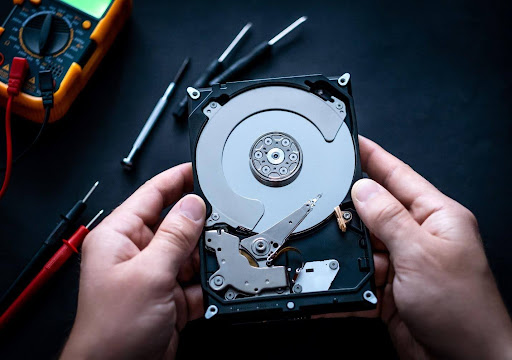When it comes to securely disposing of your old computer, you might think that simply shredding the hard drive is enough to eliminate security threats and protect your data. After all, if the drive is physically destroyed, how could anyone possibly retrieve your information?
However, the reality is that shredding alone may not be enough to ensure your data is fully protected. Here’s why shredding your hard drive isn’t the complete solution—and what you should do instead to keep your data safe.
1. Understanding Data Residuals
Even after you’ve shredded a hard drive into tiny pieces, data fragments can still remain. Skilled data recovery experts have been known to piece together these fragments, recovering partial or even complete data. While this might seem like something out of a spy movie, it’s a real threat, especially if you’re dealing with sensitive information.
Pro Tip: To truly protect your data, combine physical destruction with digital wiping techniques. This ensures that your data is not just inaccessible, but completely irretrievable.
2. The Limitations of Physical Shredding
Hard drive shredders are designed to destroy the physical components of the drive, but they don’t always guarantee that data is completely erased. In fact, some shredders might not shred the drive into small enough pieces, leaving behind chunks that could potentially be analyzed and recovered. If the drive is shredded into larger fragments, the risk of data recovery increases.
Pro Tip: When choosing a shredding service, ensure they use industrial-grade shredders that reduce the hard drive to dust-sized particles. This greatly minimizes the risk of data recovery.
3. Data on Solid-State Drives (SSDs)
Solid-state drives (SSDs) operate differently from traditional hard drives, storing data in a way that makes it even more challenging to securely erase. SSDs use a technology called wear leveling, which spreads data across the drive. This means that simply shredding an SSD doesn’t guarantee that all data fragments are destroyed. Specialized techniques are needed to ensure that data on SSDs is fully erased.
Pro Tip: Before shredding, use a software tool designed to securely erase data on SSDs. These tools are specifically designed to handle the unique challenges of SSD data wiping.
4. The Importance of Data Wiping
Before physically destroying your hard drive, it’s crucial to wipe the data digitally. Data wiping involves overwriting the entire drive with random data, making it impossible to recover the original information. This process is essential because it ensures that even if someone were to reconstruct the drive, the data would be meaningless.
Pro Tip: Use reputable data-wiping software that’s designed to meet industry standards for secure data deletion. Look for software that offers multiple overwrite passes for maximum security.
5. Why Multiple Layers of Security Matter
When it comes to data protection, redundancy is key. Relying on a single method, like shredding, isn’t enough to fully protect your data. Instead, use multiple layers of security—such as data wiping, encryption, and physical destruction—to ensure your data is completely inaccessible. This layered approach is especially important for businesses and individuals handling highly sensitive information.
Pro Tip: Implement a data destruction policy that includes multiple steps, from digital wiping to physical destruction. This not only enhances security but also provides peace of mind.
6. The Role of Encryption
Encrypting your data before it ever touches the hard drive is another effective way to protect your information. Encryption converts your data into a code that can only be decrypted with the correct key. Even if someone were to recover fragments of your data after shredding, they wouldn’t be able to access the information without the encryption key.
Pro Tip: Always encrypt sensitive data on your devices. Use strong encryption standards, such as AES-256, to ensure your data is protected from unauthorized access.
7. Proper Disposal of Mobile Devices
Mobile devices like smartphones and tablets also store a significant amount of personal data, often including access to sensitive accounts and information. Simply shredding these devices without properly wiping them first leaves you vulnerable to data recovery. Just like with hard drives, a combination of digital wiping and physical destruction is necessary for secure disposal.
Pro Tip: Before disposing of mobile devices, perform a factory reset followed by data-wiping software designed for mobile operating systems. Then, consider using a professional service to destroy the device.
8. Professional Data Destruction Services
For individuals and businesses alike, using a professional data destruction service is often the best way to ensure complete security. These services are equipped with the tools and expertise to handle large volumes of data and can provide certification that your data has been securely destroyed. They offer a comprehensive approach, combining data wiping, physical destruction, and secure disposal.
Pro Tip: Choose a data destruction service that is certified and follows industry best practices. This ensures that your data is handled with the highest level of security and compliance.
9. The Risk of DIY Destruction
While it might be tempting to destroy your hard drive yourself with a hammer or drill, this DIY approach can leave gaps in your data security. Improper destruction methods can leave larger fragments intact, increasing the risk of data recovery. Moreover, DIY methods don’t provide the same level of thoroughness as professional services.
Pro Tip: If you choose to destroy your hard drive yourself, make sure to follow up with data-wiping software and ensure the drive is reduced to the smallest possible fragments. However, professional services are always recommended for maximum security.
10. Documenting the Destruction Process
For businesses, documenting the destruction process is crucial for compliance with data protection regulations. Keeping records of how and when data was destroyed can protect your organization in the event of a data breach. Even for individuals, maintaining a record of data destruction can provide peace of mind, knowing that you’ve taken all necessary steps to protect your information.
Pro Tip: Create a checklist for data destruction that includes steps like data wiping, encryption, and physical destruction. This ensures nothing is overlooked, and you have a clear record of the destruction process.
Remember, when it comes to data security, more is more. Protect your data with multiple layers of security, and rest easy knowing that your information is safe.










